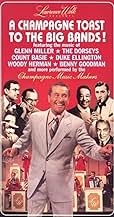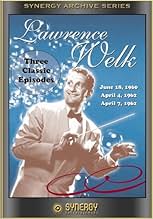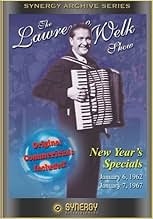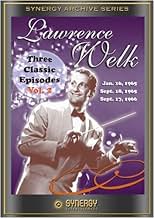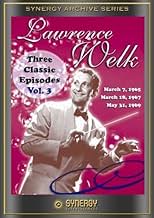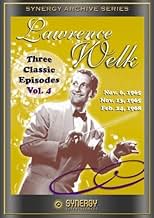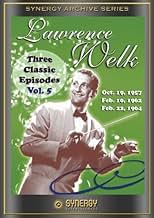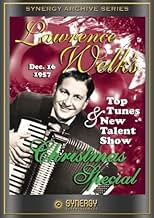Ajouter une intrigue dans votre langueOne of the most successful and fondly-remembered shows in TV history, "The Lawrence Welk Show" featured musical numbers and skits, with host Welk leading the band.One of the most successful and fondly-remembered shows in TV history, "The Lawrence Welk Show" featured musical numbers and skits, with host Welk leading the band.One of the most successful and fondly-remembered shows in TV history, "The Lawrence Welk Show" featured musical numbers and skits, with host Welk leading the band.
- Nommé pour 1 prix Primetime Emmy
- 1 nomination au total
Parcourir les épisodes
Histoire
Le saviez-vous
- AnecdotesFrom its move to network television in 1955 until the very early 1960s, the show's primary sponsor was Dodge. The Dodge name would be part of the set and during some performances, the shots would be framed so that the Dodge name would be unobstructed. As was common in the 1950s, the name of the primary sponsor would be part of the show's official title. During this period, this show's official title was "The Lawrence Welk Dodge Show."
- Citations
Lawrence Welk - Host: Wunnerful, Wunnerful.
- Autres versionsWhen the show is shown in syndication on PBS, it contains color presentation clips filmed and hosted by surviving members of the Welk musical family. This is presumably done to pad the show out to the length it would be with commercial breaks.
- ConnexionsEdited into Commercial Entertainment Product (1992)
- Bandes originalesBubbles in the Wine
by Frank Loesser, Bob Calame and Lawrence Welk
Paramount Music Corporation (ASCAP)
Commentaire en vedette
After a few years on local television, Lawrence Welk continues to host his Saturday evening song and dance variety program before a national audience for another 27 years (1955-82).
Wholesome, nostalgic, quality presentation become the order of the day, as Lawrence Welk, with his thick Germanic accent, introduces his Orchestra, singers and dancers, and sometimes comedy sketches each week, usually taking time out for one instrumental number to welcome a string of lovely audience females to spin around the dance floor.
Episodes often spotlight one select theme, with an occasional tribute to a famous songwriter, as Jerome Kern, Henry Mancini, Johnny Mercer or Harry Warren, or a tribute to a music genre, as Swing Bands, Country & Western, Patriotic Songs, Hymns or Show Tunes, or a tribute to a holiday or season, colors, states, flowers... oh, just about anything healthy and wholesome, with fashionable costuming to suit the occasion.
Lovely soprano Norma Zimmer joins the cast as Welk's "Champagne Lady" near the end of 1960, and thankfully doesn't follow up on her plans for an early retirement, which is often discussed for more then two decades throughout the program's run.
Other recognizable singers who achieve fame for many fine performances upon "The Lawrence Welk Show" include Jimmy Roberts, Bob Ralston, Bob Lido, Joe Feeney, (Dianne, Peggy, Kathy and Janet) the Lennon Sisters, Guy Hovis and Ralna English, Gail Farrell, Dick Dale and Tom Netherton plus many orchestra members and other vocalists (although it may be considered a mixed bag of sorts in that regard).
Myron Floren, the "Happy Norwegian" accordionist, stands out from the band with his friendly perpetual smile, while capably accompanying the orchestra, while standing in a well-deserved spotlight of his very own.
Jo Ann Castle also performs before the spotlight with her dynamic piano arrangements, her instrument often decorated for every event, and even igniting in flames on occasion.
Arthur Duncan steps to the beat with his famous tap dancing routines during his weekly segments, as do Bobby Burgess and Cissy King with their range of meticulously-choreographed dances, ranging from Ballroom to Country. Bobby remains upon the program a bit longer than Cissy and, therefore, has other dance partners, but when it comes to performance, these three (Arthur, Bobby and Cissy) rank right up there with the best of the all-time greats.
So, this series lives up to its promises of quality entertainment, spanning the 1950's with the 1980's, and holds up quite well today in PBS rerun packages, which are introduced by "Lawrence Welk Show" alumni, who also offer interesting behind-the-scenes commentary in lieu of commercial breaks.
Wholesome, nostalgic, quality presentation become the order of the day, as Lawrence Welk, with his thick Germanic accent, introduces his Orchestra, singers and dancers, and sometimes comedy sketches each week, usually taking time out for one instrumental number to welcome a string of lovely audience females to spin around the dance floor.
Episodes often spotlight one select theme, with an occasional tribute to a famous songwriter, as Jerome Kern, Henry Mancini, Johnny Mercer or Harry Warren, or a tribute to a music genre, as Swing Bands, Country & Western, Patriotic Songs, Hymns or Show Tunes, or a tribute to a holiday or season, colors, states, flowers... oh, just about anything healthy and wholesome, with fashionable costuming to suit the occasion.
Lovely soprano Norma Zimmer joins the cast as Welk's "Champagne Lady" near the end of 1960, and thankfully doesn't follow up on her plans for an early retirement, which is often discussed for more then two decades throughout the program's run.
Other recognizable singers who achieve fame for many fine performances upon "The Lawrence Welk Show" include Jimmy Roberts, Bob Ralston, Bob Lido, Joe Feeney, (Dianne, Peggy, Kathy and Janet) the Lennon Sisters, Guy Hovis and Ralna English, Gail Farrell, Dick Dale and Tom Netherton plus many orchestra members and other vocalists (although it may be considered a mixed bag of sorts in that regard).
Myron Floren, the "Happy Norwegian" accordionist, stands out from the band with his friendly perpetual smile, while capably accompanying the orchestra, while standing in a well-deserved spotlight of his very own.
Jo Ann Castle also performs before the spotlight with her dynamic piano arrangements, her instrument often decorated for every event, and even igniting in flames on occasion.
Arthur Duncan steps to the beat with his famous tap dancing routines during his weekly segments, as do Bobby Burgess and Cissy King with their range of meticulously-choreographed dances, ranging from Ballroom to Country. Bobby remains upon the program a bit longer than Cissy and, therefore, has other dance partners, but when it comes to performance, these three (Arthur, Bobby and Cissy) rank right up there with the best of the all-time greats.
So, this series lives up to its promises of quality entertainment, spanning the 1950's with the 1980's, and holds up quite well today in PBS rerun packages, which are introduced by "Lawrence Welk Show" alumni, who also offer interesting behind-the-scenes commentary in lieu of commercial breaks.
- WeatherViolet
- 17 sept. 2010
- Lien permanent
Meilleurs choix
Connectez-vous pour évaluer et surveiller les recommandations personnalisées
- How many seasons does The Lawrence Welk Show have?Propulsé par Alexa
Détails
- Date de sortie
- Pays d’origine
- Langue
- Aussi connu sous le nom de
- The Lawrence Welk Show
- Lieux de tournage
- sociétés de production
- Consultez plus de crédits d'entreprise sur IMDbPro
- Durée1 heure
- Mixage
- Rapport de forme
- 1.33 : 1
Contribuer à cette page
Suggérer une modification ou ajouter du contenu manquant

Lacune principale
By what name was The Dodge Dancing Party (1955) officially released in India in English?
Répondre
